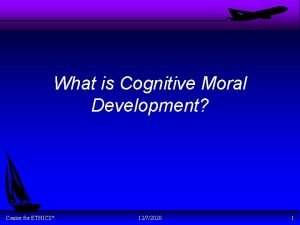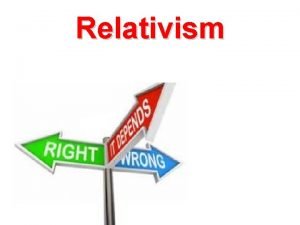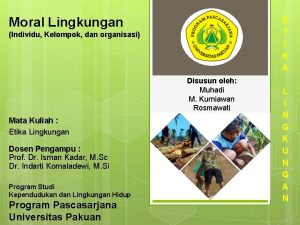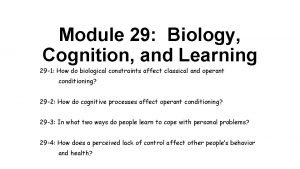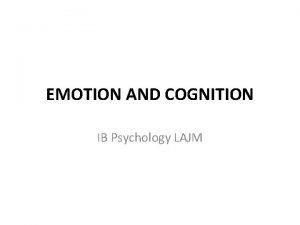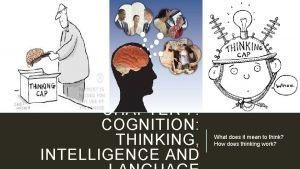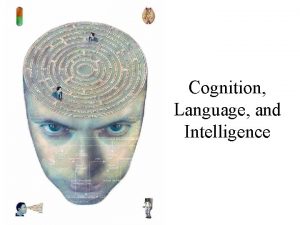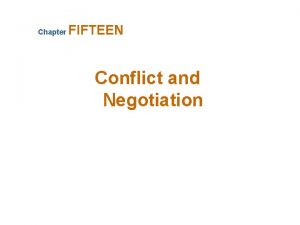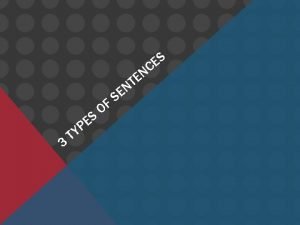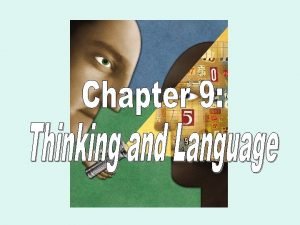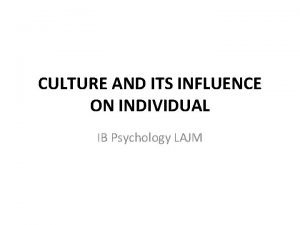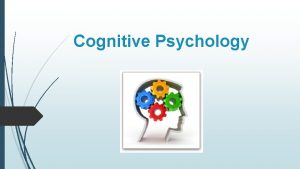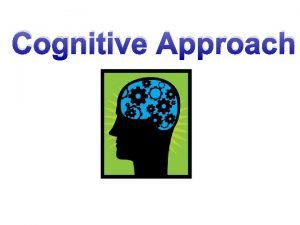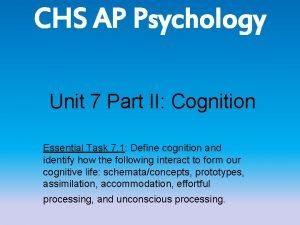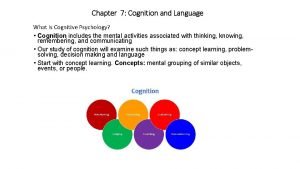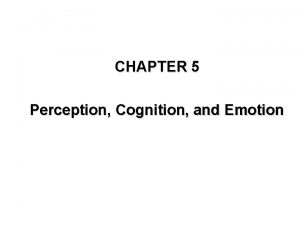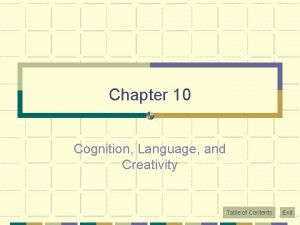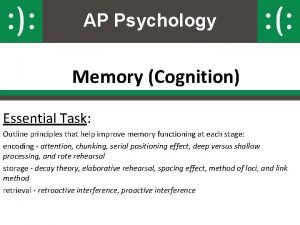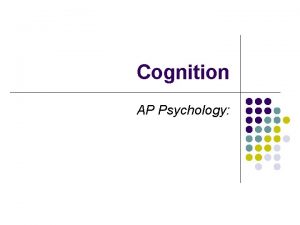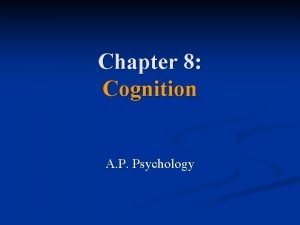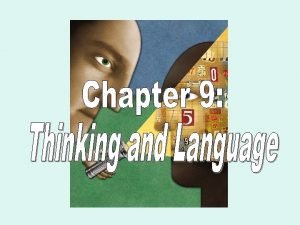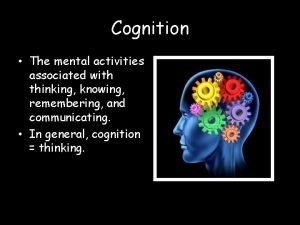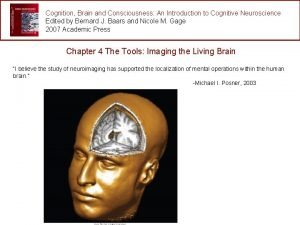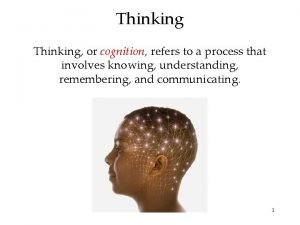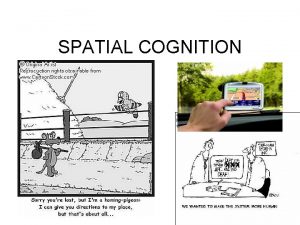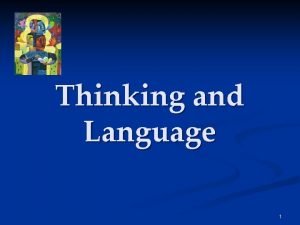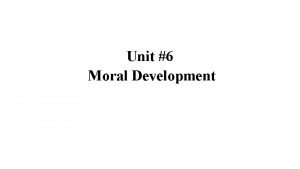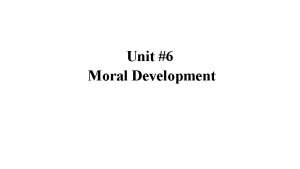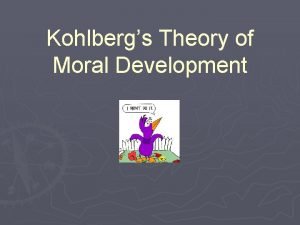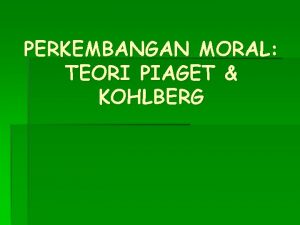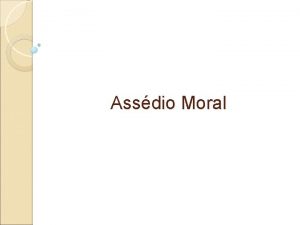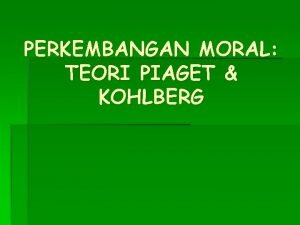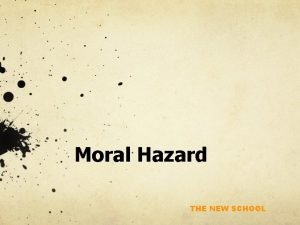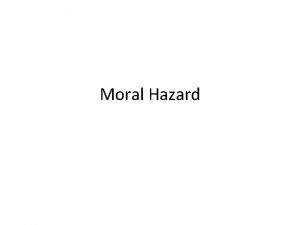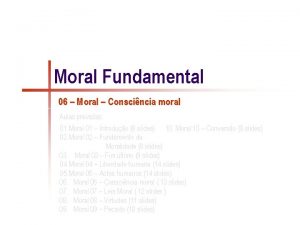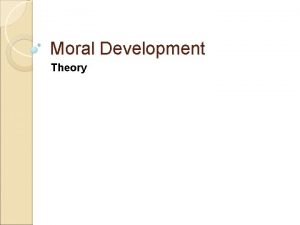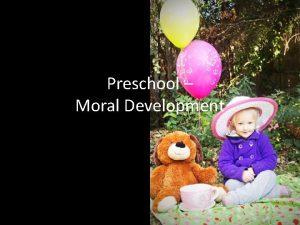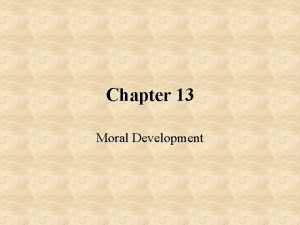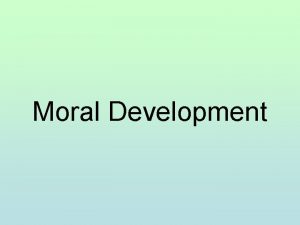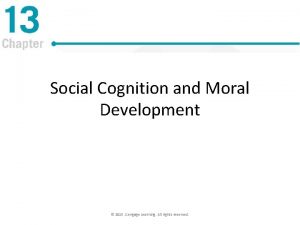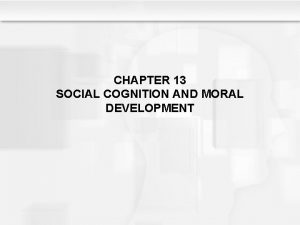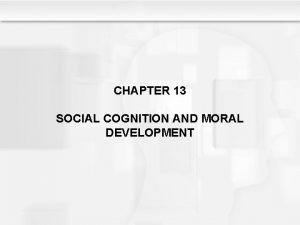Cognition and Moral Development Megan Kanatzar and Katherine




































- Slides: 36

Cognition and Moral Development Megan Kanatzar and Katherine Wright

Where did we begin… �Moral Judgment of Piaget & Kohlberg’s Stages of Moral Reasoning. �Specifically, does a child’s ability to conserve affect their score in Kohlberg’s moral reasoning? ?

Piaget (1896 -1980) � Born in Switzerland � Age 10 studied albino sparrow � Age 15 convictions lacked scientific foundation. � Age 21 earned Doctorate – natural sciences � Age 23 came up with plan of action… � 1920 decided to study children in Paris Laboratory � Interested in children’s wrong answers � Mainly observed children 4 -12(spontaneous activities) � Methodology was greatly criticized � 1960’s great revival of his work!

Piaget’s Stages: v Four stages Sensorimotor (6 subsets -Infancy) intelligence demonstrated thru motor activity without symbols Object permanence comes - 6 mnths Pre-operational (2 subsets - toddler and early childhood) use of symbols, language matures, memory/imagination develop Egocentric thinking remains dominate Concrete operational thought (7 types of conservation - elementary and early adolescence) logical, systematic manipulation of symbols operational thinking…egocentric thought diminishes Formal operational thought (adolescence and adulthood) Logical use of symbols related to abstract concepts return to egocentric thought-early on 35% high school grads achieve Formal operations

What ages? �About what ages do kids transition from preoperational to concrete operations? SENSORIMOTOR PERIOD Birth to 2 years PREOPERATIONAL PERIOD 2 -7 years CONCRETE OPERATIONS 7 -11 years FORMAL OPERATIONS 11 years-adulthood

How does Conservation relate to Piaget's stages? �Children are in considered in the Preoperational Stage if… � He or she is determined that one glass has more water than the other. �Children are considered in a transitional sub-stage if… � He or she can’t decide between the two glasses, or shows signs of beginning to grasp the concept, but does not yet get it. �Children are considered in Concrete operational if… � He or she clearly knows that the glasses still have the same amount of water. The child can also use the 3 arguments of – identity, compensation, inversion – to justify their opinion.

Kohlberg (1927 -1987) �Hometown: Bronxville, New York �Attended the University of Chicago �He became interested in Piaget’s work, specifically in his investigation of moral judgments in children. �Kohlberg took Piaget’s brief work with moral development and expanded it extensively.

Kohlberg’s dilemmas �Kohlberg tested children by presenting the children with a moral dilemma, and asking them questions to ascertain their understanding of morality. �The ‘yes’/ ‘no’ responses were not the main criteria for placement in a particular stage of moral development. The explanation of why the child holds a certain opinion that reveals how advanced their moral judgments are.

Your Turn! � Dilemma: Two young men, brothers, had got into serious trouble. They are secretly leaving town in a hurry and needed money. Karl, the older one, broke into a store and stole a thousand dollars. Bob, the younger one, went to a retired old man who was known to help people in town. He told the man that he was very sick and that he needed a thousand dollars to pay for an operation. Bob asked the old man to lend him the money and promised that he would pay him back when he recovered. Really Bob wasn’t sick at all, and he had no intention of paying the man back. Although the old man didn’t know Bob very well, he lent him the money. So Bob and Karl skipped town, each with a thousand dollars.

The Questions: 1) 2) 3) 4) 5) 6) 7) Which is worse, stealing like Karl or cheating like Bob? Why is that worse? What do you think is the worst thing about cheating the old man? Why is that the worst thing? In general, why should a promise be kept? Is it important to keep a promise to someone you don’t know well or will never see again? Why shouldn’t someone steal from a store? What is the value or importance of property rights? Should people do everything they can to obey the law? Why or why not?

How Kohlberg Grades �In Kohlberg’s dissertation, he provided example answers for each of the questions in this dilemma. He also compiled a list of common trends and key words to look for in the children’s answers.

Stage 1: Obedience and Punishment Orientation �The child understands rules to be set and given by a higher authority. �Their main concern is with the consequences, whether the person will be punished or not. Typically this stages is seen between the ages of 4 and 10. For example, a stealing is wrong “because you can go to jail for a very long time. Plus you can get in serious trouble” -4 th grade girl (age 9)

Stage 2: Individualism and Exchange �Punishment is no longer ‘evidence’ that something is wrong. Instead, it is “a risk that one naturally wants to avoid” (Crain 160). �The idea of right and wrong is slightly more flexible, and the first priority is doing what is most beneficial for themselves. For example, “stealing is worse [than cheating] because you are more likely to get in trouble for stealing than cheating”. -6 th grade girl (11)

Stage 3: Good Interpersonal Relationships �Strong desire to win approval from peers and adults. �Emphasis on avoiding disapproval. �Kids tend to cite a person’s intentions, or motives as proof of right & wrong. For example, cheating is wrong “because you’re always supposed to do the right thing”. -4 th grade girl (age 9)

Stage 4: Maintaining the Social Order �Child becomes more concerned with society as a whole, and how the rules are made for a purpose. � ‘people want to keep society functioning’ (Crain 162) �Can focus on the effect an action has on society. For example, keeping promises is important because “when you promise something, you follow through with it, and hold your end of the bargain”. 6 th grade girl (age 12)

Stage 5: Tertiary Circular Reactions �The person is generally entering adolescence at this stage, and they are able to consider ‘the big picture’ or society as a whole. �They have respect for the laws not because they are told to, but because it is detrimental to society if they disobey. For example, stealing is worse than cheating because “you are doing something bad, the cops will chase you could hurt someone in the process” – 8 th grade boy (age 14)

Stage 6: The Beginning of Thought/ Universal Principles �The person considers how the characters in the dilemma can best achieve a just result. �The person also examines the parameters of the situation to see if they are most likely to promote a good outcome. For example, when someone is given the Heinz dilemma, they might say that their should be laws forbidding price gauging in pharmacies.

Question / Purpose �The purpose of our study is to discover if Piaget’s and Kohlberg’s theories of cognitive development complement each other. �“Do children who are able to conserve score higher or lower on Kohlberg’s moral development stages than children who fail to conserve? ”

Hypothesis If a child demonstrates the ability to conservation , he or she will also demonstrate more advanced moral reasoning than the children who could not conserve.

Materials �Worksheets for the Kids �Two identically sized cups �One graduated cylinder �Water �Blue food coloring (optional) �And children ranging from ages 9 -14

Handouts �On the first side of the handout was … � their age, grade, and gender � The questions regarding conservation – ‘which glass has more water in it? ’ �On the second side of the handout was… � One of Kohlberg’s dilemma � Questions that Kohlberg wrote himself for that particular dilemma.

Our test subjects… �Holy Family of Nazareth School We tested children in grades 4, 6, and 8. �When Kohlberg performed his investigations, he tested kids at ages 10, 13, and 16.

Procedure 1. Children sat together in a group. 2. Hand out the pencils, and evaluation sheets. 3. Then, we will fill up two plastic cups with equal amounts of water. 4. Next, we will pour the water from one cup into a different size cup, taking all the water from one to the other. 5. Now ask them whethere is more or less water in the second cup compared to the first one. Have them record what they think on the worksheet, 6. Then, we will read the dilemma to them (which will also be written on the worksheet). 7. Then the students will answer the questions about the dilemma on their worksheets.

The children’s results �Overall, we compared the moral development level of the children who could conserve to those who could not conserve. �Each grades data was slightly different…

4 th Graders 6 4 th Graders who CAN conserve: Moral 5 L 4 E V 3 E 2 L 1 0 1 2 Fourth Graders 3

4 th Grader (cont'd) Moral L E V E L 6 4 th Graders who can NOT conserve: 5 4 3 2 1 0 1 2 3 4 Fourth Graders 5 6

6 th Graders Moral L E V E L 6 6 th Graders who CAN conserve: 5 4 3 2 1 0 1 2 Sixth Graders 3 4

8 th Graders There was only 1 eighth grader, and he was able to conserve. His Moral Reasoning level was determined to be in level 5.

Next, the Overall Results… Drum roll, please…

******Overall Results******* 3. 5 3 2. 875 2. 5 Average Moral 2 Development Levels 1. 5 1. 833 1 0. 5 0 Those who CAN Conserve Those who Can NOT Conserve

Average Moral Development for those who CAN conserve 6 AVG. L E V E L 5 4 3 2 1 0 4 th Grade 6 th Grade 8 th Grade

Those Who Can NOT Conserve… 6 AVG. 5 4 L E 3 V 2 E 1 L (None) 6 th Grade 8 th Grade 0 4 th Grade

Evaluation of the Results �Overall, our hypothesis was confirmed. �The average stage of moral reasoning of the children who could conserve was slightly higher than the children who could not conserve. �However, given the limited amount of test subjects we were able to test, the results are not as adequate as we would have liked.

Looking Back, �If we could do the project over again what would we change? � Environment where the kids were tested was very loud and chaotic. �Accuracy of results? � If any errors were made, it is likely they were made in the grading of the children’s moral reasoning answers.

Bibliography (Main Sources) �Crain, William C. "Piaget's Cognitive-Developmental Theory. " Theories of Development: Concepts and Applications. Boston, MA: Prentice Hall, 2011. �Kohlberg, Lawrence (1958). "The Development of Modes of Thinking and Choices in Years 10 to 16". Ph. D. dissertation, University of Chicago. �Kohlberg, Lawrence. The Philosophy of Moral Development: Moral Stages and the Idea of Justice. San Francisco: Harper & Row, 1981.

 Moral cognition
Moral cognition The dolls house by katherine mansfield moral lesson
The dolls house by katherine mansfield moral lesson Bambrough moral scepticism and moral knowledge download
Bambrough moral scepticism and moral knowledge download Human choice cuts
Human choice cuts Moral kelompok adalah
Moral kelompok adalah Moral de esclavos y moral de señores
Moral de esclavos y moral de señores Chapter 7 cognition thinking intelligence and language
Chapter 7 cognition thinking intelligence and language Module 29 biology cognition and learning
Module 29 biology cognition and learning Emotion and cognition ib psychology
Emotion and cognition ib psychology Cognition thinking intelligence and language
Cognition thinking intelligence and language Does language reflect intelligence
Does language reflect intelligence Cognition and personalization
Cognition and personalization Megan and ron ate too much and felt sick.
Megan and ron ate too much and felt sick. Cognition refers to
Cognition refers to Mental statis exam
Mental statis exam Sensorium mse
Sensorium mse Delavario et al (2013)
Delavario et al (2013) What is cognition
What is cognition Cognition definition
Cognition definition Embodied cognition ap psychology
Embodied cognition ap psychology What is cognition
What is cognition Types perception
Types perception Altered cognition in older adults is commonly attributed to
Altered cognition in older adults is commonly attributed to What is cognition
What is cognition Cognition definition
Cognition definition Embodied cognition ap psychology
Embodied cognition ap psychology Ap psychology unit 7 cognition
Ap psychology unit 7 cognition Konsep ketersediaan heuristik
Konsep ketersediaan heuristik Embodied cognition ap psychology definition
Embodied cognition ap psychology definition Belief bias ap psychology
Belief bias ap psychology Embodied cognition ap psychology
Embodied cognition ap psychology Cognition refers to
Cognition refers to The mental activities associated with thinking
The mental activities associated with thinking Complex cognition
Complex cognition Cognitive dissonance definition
Cognitive dissonance definition Spatial cognition examples
Spatial cognition examples Linguistic determinism
Linguistic determinism
